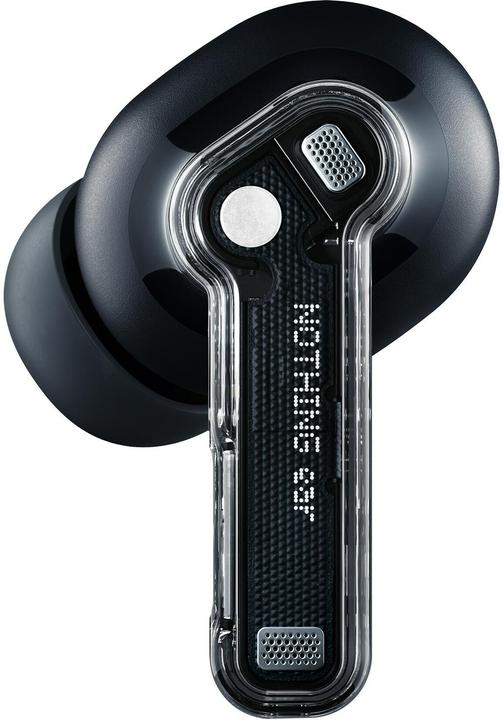

Review: the Nothing Ear and Nothing Ear (a) are both outstanding earbuds
At first glance, the Nothing Ear and its budget-friendlier sibling, the Nothing Ear (a), don’t look like they’ve been given an extreme makeover. The tech inside them, however, is supposedly a step up from their predecessor’s.
Following on from the Ear (2), the Nothing Ear and the Nothing Ear (a) are said to boast better noise cancellation, battery life, sound and protection against earwax than their predecessor. Nothing’s more expensive earbuds hit higher standards. By omitting some of these features in the cheaper Ear (a), the manufacturer’s lowered the price without compromising on sound.
The Nothing Ear looks almost exactly like its predecessor. The Ear (a), on the other hand, is easier to distinguish as a result of its pillbox-inspired case. Both pairs of earphones come in black or white, and the Ear (a) is also available in yellow. Nothing says that in Japan, where the manufacturer first showcased the new earbuds, yellow stands for hope and positivity. Looking at the earbuds outside the case, the only way to tell the Ear and the Ear (a) apart is by the different sizes of stem – or the name printed on them.
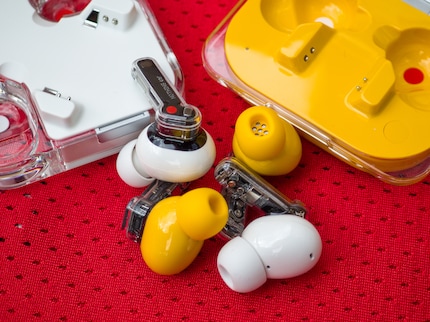
Source: Jan Johannsen
The key differences
Nothing’s scrimped on some software functions and materials in order to make the Ear (a) cheaper than the Ear. More specifically:
- The membrane of the Ear (a) is made of plastic, while the Ear’s is ceramic.
- The only Hi-Res codec supported by the Ear (a) is LDAC. However, the Ear also supports LDHC 5.0.
- You can’t get a personal sound profile on the Ear (a), and it doesn’t have an enhanced equaliser.
- The Ear (a)’s case is less robust against dust and water. While the Ear’s case is IP55-certified, the Ear (a)’s affords just IPX2 protection.
- The Ear (a) doesn’t offer wireless charging.
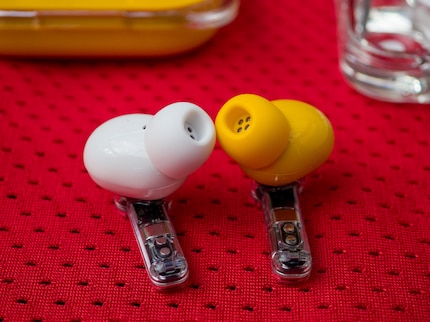
Source: Jan Johannsen
Although both earphones are fitted with the same batteries, there are slight differences in battery life. Though both models support Bluetooth 5.3, Fast Pair and Dual Connection, you’ll have to do without spatial audio. According to Nothing, the function isn’t yet feasible for earphones in this price range.
Comfortable to wear and straightforward to use
Both sets of earbuds feel almost exactly the same to wear and use. They sit comfortably in my ears, and are in no danger of falling out. The most significant difference between them is the case – the Ear (a)’s is slightly more difficult to open. The protruding frame on the bottom and top half is so narrow that my fingers usually cover both and I have to readjust to open it.
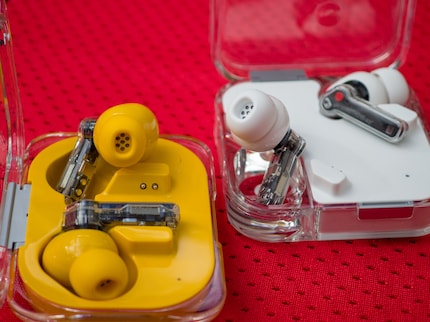
Source: Jan Johannsen
Each set of earbuds boasts IP54 protection against dust and splashes of water, so neither rain nor sweat should do them any harm. What’s more, new filters in the ear tips are designed to prevent earwax from getting into the earphones. When I remove the tips, they’re easy to clean.
As is typically the case with Nothing products, pinching the earphones’ stems activates the controls. Pressing once starts and pauses playback and answers or ends a call. When it comes to double- and triple-tapping, you have three options to choose from in the Nothing X app: skip to the previous song, jump to the next track or open your phone’s voice assistant. Pressing then holding or double-tapping then holding will switch between noise cancellation and transparency mode or adjust the volume.
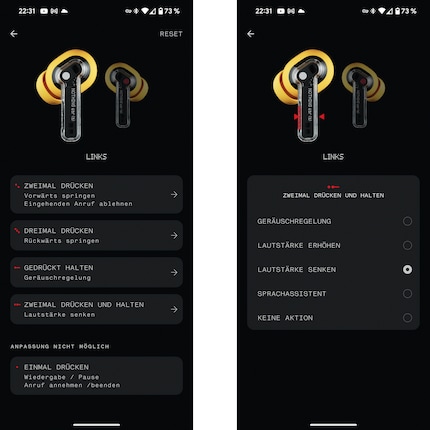
Source: Jan Johannsen
Using the Nothing X app, you begin to notice the functional difference between the Ear and Ear (a). With the more expensive model, the Ear, you have a more advanced equaliser at your disposal, and can create a personal sound profile.
Good sound made better
Both of Nothing’s new earphones use Bluetooth 5.3. They don’t yet support [Auracast](/page/auracast-der-neue-bluetooth-standard-genau-erklaert-32491, but they do offer AAC and SBS, as well as the Hi-Res codec LDAC. The pricier model also has LDHC 5.0. To cut costs, Nothing hasn’t equipped the buds with aptX.
Nothing has fitted the Ear with ceramic drivers. This costlier material supposedly delivers better sound than the plastic drivers in the Ear (a). The drivers in both earphones are 11 millimetres in size.
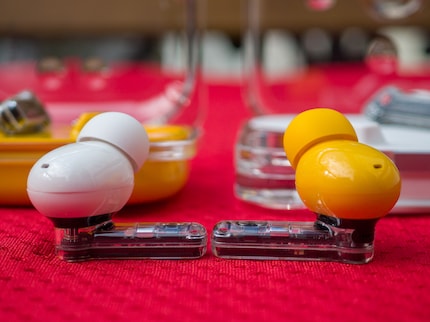
Source: Jan Johannsen
I use both models with default settings enabled, keeping Nothing’s new bass-boosting algorithm on medium. On the whole, I’m really pleased with how both sets of earphones sound. They’re right up there with top-of-the-line in-ears. The bass is easy to make out, but not overpowering. Meanwhile, the mids are nicely accentuated and the treble comes across clearly.
The differences between the headphones are also minimal in terms of sound. I’d say the bass is slightly stronger with the Ear (a), while the treble comes through a little clearer with the Ear. This ties in with Nothing’s statement on the earphones, which I’d forgotten by the time I came to testing them. Hopefully, it didn’t have any unconscious influence over me.
The Ear’s higher price tag is justified – mostly because of the additional options in the app. The simple equaliser alone – available in the Nothing X app and featuring three bands for bass, mids and treble – has a noticeable impact on the audio. You can use it to adjust the playback of both earphones to your preferences. If that’s not enough for you, the Ear has an enhanced equaliser with eight bands, making even more fine-tuning possible.
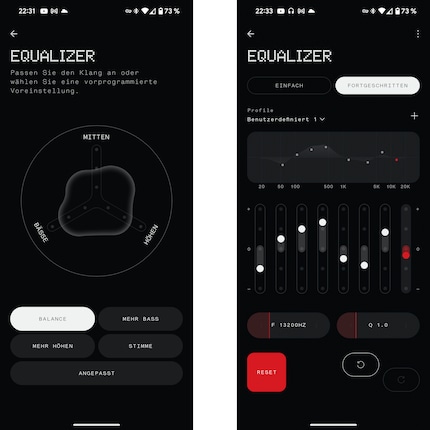
Source: Jan Johannsen
You can create a personal sound profile with the Ear
If you don’t fancy fiddling around with all these digital dials yourself, the Ear gives you the option of creating a personal sound profile. Nothing has used technology created by a company named Mimi for this. During the test, you hear a continuous tone. Any time you hear an additional beep, you need to hold down the large button on the touchscreen until it stops. The app uses this data on the strength of your hearing to make additional adjustments. This in turn is supposed to boost sounds you’re less able to perceive. Once the profile’s been created, it can be switched on and off.
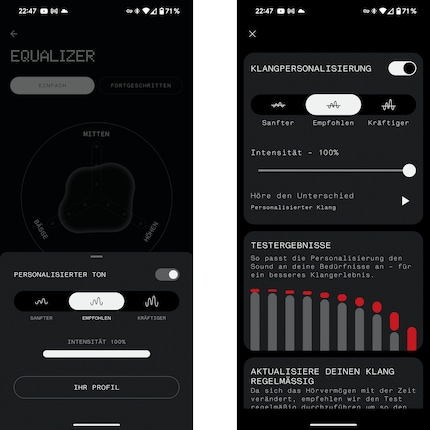
Source: Jan Johannsen
I like having the option to do that. When listening to music, I feel like I can hear more details with the sound profile switched on. That being said, these details are accompanied by a gentle scratching sound. It reminds me of the sound of a vinyl record player. However, if I’m listening to something where only the vocals are important, such as a podcast, I prefer keeping the sound profile switched off. When activated, it makes familiar voices sound different without enhancing the sound spectrum in any way. As for radio plays featuring a range of sounds, it’s a different story. I’m still on the fence when it comes to using the sound profile for those.
Call quality
Nothing has equipped the Ear and the Ear (a) with three microphones per earbud. Positioned differently to the mics in the Ear (2), they’re supposed to produce less wind noise. Both sets of new earphones have also been kitted out with the manufacturer’s Clear Voice Technology. This considered, there should be no difference between the two in terms of sound:
When used in quiet places, you hear significantly less noise interference with the new earphones than with their predecessor. In loud environments, however, all three manage to filter out background noise. On the flip side, this seriously compromises voice quality. The Ear (a) is noticeably poor in this regard. Even my smartphone’s microphone, with audible background noise, does a better job.
Let in your surroundings – or don’t
Nothing has made improvements to its active noise cancellation (ANC). Enhancements the manufacturer claims reduce background noise by up to 45 decibels in both the Ear and the Ear (a). Their predecessor, the Ear (2), only managed 40 decibels. You can either choose between the three different noise cancellation levels available, or have the earphones select a level automatically.
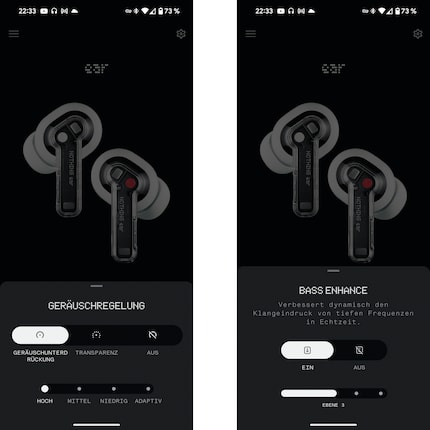
Source: Jan Johannsen
In quieter environments, I can hear a little bit of gentle static, which I recognise as the sound of the ANC itself. It doesn’t bother me. If my surroundings get louder, the static stops – and I’m really satisfied with the active noise cancellation. I can listen to podcasts at the side of a noisy road while keeping the volume at a regular level. In the office, if I’m listening to music with ANC activated, my colleagues need to physically approach me when they want to talk to me. I can only hear voices if they’re right next to me.
Transparency mode proves to be really helpful when I want to hear my surroundings. It transmits voices and other sounds to my ear without delay via the microphones in the earbuds. As a result, I hear my surroundings better than if I’d simply deactivated the ANC.
Long-lasting batteries
The batteries in the Ear and Ear (a) each offer 25 per cent more capacity than the Ear (2). In the specs, Nothing outlines two different battery capacities for its new in-ears. Whichever model you go for, you can listen to music for five hours and recharge the earbuds in the charging box for another 24 hours. If you switch off the active noise cancellation, battery life increases by 3-4 hours for the earphones and 16 hours for the case.
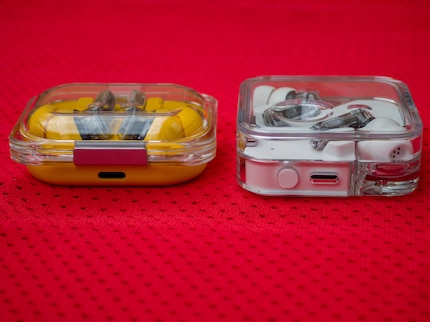
Source: Jan Johannsen
Both models have a relatively long battery life. They can be charged via the case’s USB-C port. Just ten minutes should be enough to listen to music with ANC for five hours. You can even get ten hours with noise cancellation switched off. Wireless charging takes a little longer, but only the Nothing Ear has this feature. In a bid to keep costs down, Nothing hasn’t equipped the Ear (a) with wireless charging.
Both very good, buying the pricier ones is worth the investment
Both of Nothing’s new wireless earphones impress me. They’re easy to use, comfortable to wear and they sound really good. Their only downside is poor voice quality when making calls in louder environments.
As for the cheaper earbuds, the Ear (a), their biggest drawback is that the case is slightly difficult to open. The Ear’s higher price tag proves to be justified, with the enhanced equaliser and personalised sound profile allowing for individual sound customisation.
Both earbuds are set to be released on 22 April. While the recommended retail price for the Ear (a) is 99 euros or francs, the Ear will set you back 149 euros or 139 francs.
In a nutshell
Both very good, buying the pricier ones is worth the investment
Both of Nothing’s new wireless earphones impress me. They’re easy to use, comfortable to wear and they sound really good. Their only downside is poor voice quality when making calls in louder environments.
As for the cheaper earbuds, the Ear (a), their biggest drawback is that the case is slightly difficult to open. The Ear’s higher price tag proves to be justified, with the enhanced equaliser and personalised sound profile allowing for individual sound customisation.
Both earbuds are set to be released on 22 April. While the recommended retail price for the Ear (a) is 99 euros or francs, the Ear will set you back 149 euros or 139 francs.
As a primary school pupil, I used to sit in a friend's living room with many of my classmates to play the Super NES. Now I get my hands on the latest technology and test it for you. In recent years at Curved, Computer Bild and Netzwelt, now at Digitec and Galaxus.



